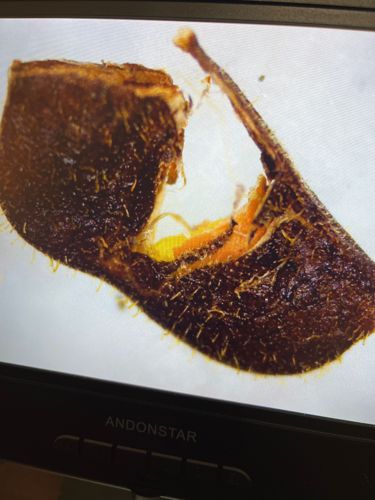Honey Bee Leg (part of a worker bee)
Scientific Name: Apis mellifera (common European honey bee, though other Apis species exist)
Order & Family: Order: Hymenoptera, Family: Apidae
Size: (Focusing on the leg part in the image) The leg itself is a few millimeters to slightly over a centimeter. A full worker honey bee is typically 10-15 mm (0.4-0.6 inches) in length.

Natural Habitat
Honey bees are found globally, inhabiting a diverse range of natural and agricultural environments where flowering plants are abundant. Nests are typically built in sheltered locations like hollow trees, rock crevices, or man-made beehives.
Diet & Feeding
Pollen (for protein) and nectar (for carbohydrates) collected from flowers.
Behavior Patterns
Bee legs are designed for collecting and carrying pollen. The hind legs of worker bees have specialized structures called pollen baskets (corbiculae) where they pack gathered pollen. Bees are highly social insects that live in colonies, typically consisting of a queen, drones, and thousands of worker bees. They communicate through dances (e.g., waggle dance) to indicate food sources. They are known for their intricate nest building (honeycombs for honey storage and brood rearing).
Risks & Benefits
Benefits: Honey bees are crucial pollinators for many crops and wild plants, contributing significantly to biodiversity and food production. They produce honey, beeswax, propolis, and royal jelly, which have economic and medicinal value. Risks: Stings can be painful and cause allergic reactions in sensitive individuals (anaphylaxis). While generally beneficial, large swarms can sometimes be considered a nuisance if they nest in inconvenient locations.
Identified on: 9/4/2025